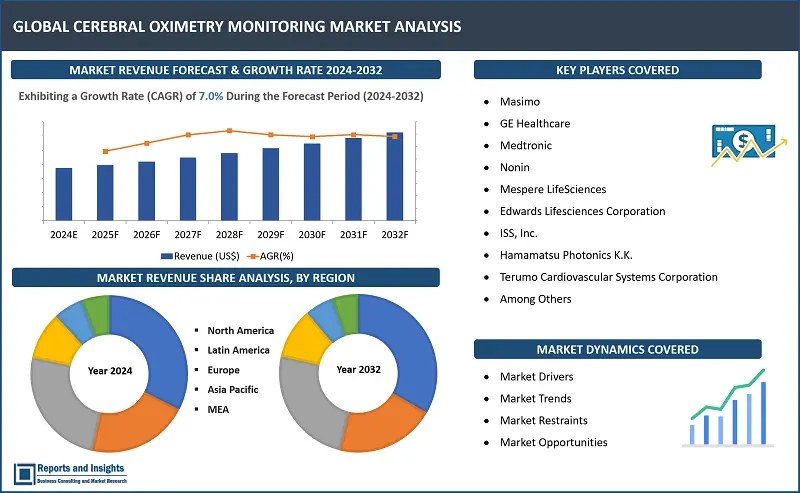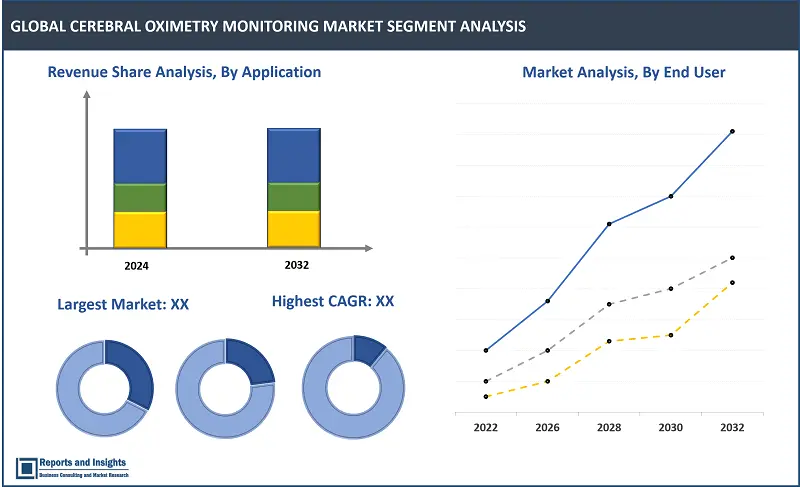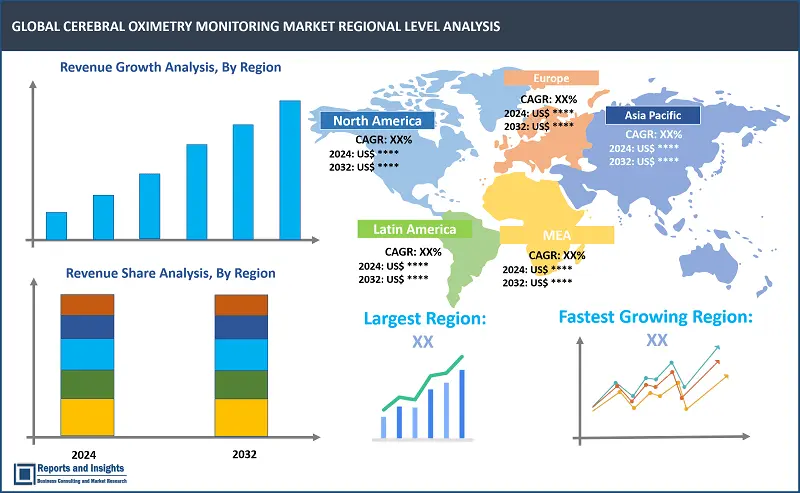Market Overview:
"The cerebral oximetry monitoring market was valued at US$ 212.6 million in 2023, and is expected to register a CAGR of 7.0% over the forecast period and reach US$ 390.9 million in 2032."
|
Report Attributes |
Details |
|
Base Year |
2023 |
|
Forecast Years |
2024-2032 |
|
Historical Years |
2021-2023 |
|
Cerebral Oximetry Monitoring Market Growth Rate (2024-2032) |
7.0% |
The cerebral oximetry monitoring market is observing a remarkable soar steered by increasing awareness and adoption of non-invasive techniques for monitoring brain oxygenation levels. Cerebral oximetry holds a crucial role in analysing cerebral perfusion and oxygenation, specifically in critical care settings such as neurosurgery, cardiac surgery, and intensive care units. This technology provides real-time, continuous monitoring, allowing healthcare professionals to immediately discern and alleviate cerebral ischemia or hypoxia, thus downplaying the risk of neurological complexities and enhancing patient outcomes. Developments in sensor design, signal processing algorithms, and incorporation with other monitoring systems are improving the precision and reliability of cerebral oximetry devices. In addition, the growing prevalence of neurological disorders, along with the geriatric population and growing surgical procedures, further accelerates the demand for cerebral oximetry monitoring solutions. Since healthcare systems prioritize patient safety and quality of care, the cerebral oximetry monitoring market is poised for sustained growth and innovation.
One of the prominent trends of global cerebral oximetry monitoring is the integration of cerebral oximetry with multimodal monitoring systems, fusing it with other parameters such as intracranial pressure and regional cerebral blood flow for a comprehensive evaluation of brain health. Additionally, there is an increasing focus on miniaturization and portability, resulting in the development of handheld and wearable cerebral oximeters, supporting uninterrupted monitoring in varied healthcare settings comprising ambulances and remote locations. Over and above, innovations and breakthroughs in sensor technology and signal processing algorithms are further improving the accuracy and reliability of cerebral oximetry measurements, enabling more precise detection of cerebral hypoxia or ischemia. Furthermore, with increasing research focusing on the relationship between cerebral oxygenation and patient outcomes, there is a rising demand for cerebral oximetry monitoring in both clinical practice and research settings. These trends jointly boost the global cerebral oximetry monitoring market towards a steady rise and innovation.

Cerebral Oximetry Monitoring Market Trends and Drivers:
In the first instance, there is a growing necessity for non-invasive monitoring techniques in healthcare settings, specifically in crucial care scenarios such as neurosurgery and cardiac surgery. Cerebral oximetry offers a real-time evaluation of brain oxygenation levels without invasive procedures, thus lessening patient discomfort and mitigating the risk of complexities.
Secondarily, the increasing elderly population across the world contributes considerably to market growth. With aging comes a higher prevalence of chronic conditions like cardiovascular illnesses, which often need surgical interventions where cerebral oximetry monitoring becomes essential for patient safety and outcome optimization.
On top of that, there is an elevated public awareness of the benefits of cerebral oximetry monitoring in ensuring improved post-operative neurological results. Patients and healthcare providers increasingly recognize the significance of monitoring cerebral oxygenation levels to avoid complexities such as brain injury during surgical procedures.
Additionally, ongoing technological advancements, comprising the development of portable and wearable cerebral oximetry devices, further propel market expansion by allowing continuous monitoring in different healthcare settings.
All in all, these critical factors gather to create a positive environment for the growth of the global cerebral oximetry monitoring market, with soaring demand projected over the forecast future.
Cerebral Oximetry Monitoring Market Restraining Factors:
Whilst the global cerebral oximetry monitoring market is witnessing significant growth, it also experiences numerous restraining factors. One notable challenge is the increased cost related to cerebral oximetry monitoring devices and associated consumables, confining their accessibility, specifically in resource-constrained healthcare settings.
In addition, reimbursement policies for cerebral oximetry procedures vary across various regions, building uncertainty for healthcare providers and hampering market growth. Along with that, the intricacy of rendering cerebral oximetry data and amalgamating it into clinical decision-making processes presents an impediment to widespread adoption.
What is more, concerns regarding the reliability and precision of cerebral oximetry measurements in various patient populations, such as those with darker skin pigmentation or peripheral vascular disease, are likely to hinder market expansion. Regulatory hurdles and compliance requirements also poses challenges for manufacturers seeking to introduce advanced cerebral oximetry monitoring products to the market.
Cerebral Oximetry Monitoring Market Opportunities:
Primarily, with the growing demand for state-of-the-art medical technology in developing nations, there is a substantial opportunity to penetrate into untapped and emerging markets. As healthcare infrastructure improves and awareness of cerebral oximetry benefits surges, these regions puts forward unused potential for market players to launch their monitoring solutions.
Apart from that, exploring novel applications for cerebral oximetry monitoring beyond conventional healthcare settings offer another avenue for growth. Industries like sports medicine and aviation can benefit from real-time monitoring of brain oxygenation levels to improve performance and safety. For instance, athletes could use cerebral oximetry to maximize training regimes, while pilots could minimize the risk of hypoxia during flights.
Furthermore, the surging need for remote patient monitoring and home healthcare services presents opportunities for the development of portable and user-friendly cerebral oximetry devices. These devices could allow patients to monitor their brain oxygenation levels conveniently at home, promoting early detection of potential issues and enhancing overall patient care.
Cerebral Oximetry Monitoring Market Segmentation:

By Application
- Cardiac Surgery
- Vascular Surgery
- Others
The cardiac surgery segment holds the dominant position in the global cerebral oximetry monitoring market attributing to the high prevalence of cardiac procedures requiring precise monitoring of brain oxygenation levels to mitigate the risk of neurological complications, such as stroke or cognitive impairment, during surgery.
By Age Group
- Paediatric
- Adult
The adult segment holds the dominant position in the global cerebral oximetry monitoring market due to the higher prevalence of neurological conditions and cardiac surgeries in the adult population compared to paediatric patients. Additionally, the complexity of adult surgeries often necessitates cerebral oximetry monitoring for optimal patient outcomes.
By End User
- Hospitals & Clinics
- Ambulatory Surgical Centres
- Others
The hospitals & clinics segment holds the dominant position in the global cerebral oximetry monitoring market owing to the extensive use of cerebral oximetry in various medical procedures performed in hospital settings. Hospitals and clinics are equipped with the necessary infrastructure and expertise to integrate cerebral oximetry monitoring into their standard care protocols effectively.
By Region

North America
- United States
- Canada
Europe
- Germany
- United Kingdom
- France
- Italy
- Spain
- Russia
- Poland
- Benelux
- Nordic
- Rest of Europe
Asia Pacific
- China
- Japan
- India
- South Korea
- ASEAN
- Australia & New Zealand
- Rest of Asia Pacific
Latin America
- Brazil
- Mexico
- Argentina
Middle East & Africa
- Saudi Arabia
- South Africa
- United Arab Emirates
- Israel
- Rest of MEA
The global cerebral oximetry monitoring market is divided into five key regions: North America, Europe, Asia Pacific, Latin America, and the Middle East and Africa. The North America segment dominates the global cerebral oximetry monitoring market attributing to numerous major factors. Primarily, the region blusters advanced healthcare infrastructure and facilities, promoting widespread adoption of advanced medical technologies like cerebral oximetry. In the second place, increased healthcare expenditure, along with favourable reimbursement policies, advocates the integration of cerebral oximetry into standard clinical practices. In addition, the presence of distinguished market players and continuous research and development initiatives contribute to the region's leadership position. Furthermore, stringent regulatory frameworks ensure product quality and safety, further spurring North America's dominance in the cerebral oximetry monitoring market.
Leading Companies in Cerebral Oximetry Monitoring Market & Competitive Landscape:
The global cerebral oximetry monitoring market presents a competitive landscape marked by the presence of prominent players such as Medtronic plc, Masimo Corporation, and Nonin Medical, among others. These companies focus on strategic initiatives such as mergers and acquisitions, product innovations, and geographical expansions to strengthen their market position. Additionally, they invest significantly in research and development to introduce advanced cerebral oximetry monitoring solutions with enhanced functionalities. Along with that, collaborations with healthcare institutions and academic research centres allow key players to leverage expertise and resources for product development and market penetration.
These companies include:
- Masimo
- GE Healthcare
- Medtronic
- Nonin
- Mespere LifeSciences
- Edwards Lifesciences Corporation
- ISS, Inc.
- Hamamatsu Photonics K.K.
- Terumo Cardiovascular Systems Corporation
Recent Development:
- In January 2023, Masimo announced the launch of its Root®6700 Cerebral Oximeter, a portable device that provides continuous monitoring of cerebral oxygen saturation (SpO2) and regional cerebral oxygen saturation (rSO2).
Cerebral Oximetry Monitoring Market Research Scope
|
Report Metric |
Report Details |
|
Cerebral Oximetry Monitoring Market size available for the years |
2021-2023 |
|
Base Year |
2023 |
|
Forecast Period |
2024-2032 |
|
Compound Annual Growth Rate (CAGR) |
7.0% |
|
Segment covered |
Application, Age Group, End User, and Region |
|
Regions Covered |
North America: The U.S. & Canada Latin America: Brazil, Mexico, Argentina, & Rest of Latin America Asia Pacific: China, India, Japan, Australia & New Zealand, ASEAN, & Rest of Asia Pacific Europe: Germany, The U.K., France, Spain, Italy, Russia, Poland, BENELUX, NORDIC, & Rest of Europe The Middle East & Africa: Saudi Arabia, United Arab Emirates, South Africa, Egypt, Israel, and Rest of MEA |
|
Fastest Growing Country in Europe |
The U.K. |
|
Largest Market |
North America |
|
Key Players |
Masimo, GE Healthcare, Medtronic, Nonin, Mespere LifeSciences, Edwards Lifesciences Corporation, ISS, Inc., Hamamatsu Photonics K.K., Terumo Cardiovascular Systems Corporation, among others |
Frequently Asked Question
What is the market size of the cerebral oximetry monitoring market in 2022?
The cerebral oximetry monitoring market size reached US$ 212.6 million in 2023.
At what CAGR will the cerebral oximetry monitoring market expand?
The market is expected to register a 7.0% CAGR through 2024-2032.
Which is the fastest growing country in Europe?
UK is the fastest growing country in Europe.
What are some key factors driving revenue growth of the cerebral oximetry monitoring market?
The increasing need for non-invasive monitoring methods in healthcare settings, the expanding elderly population, and prevalence of chronic conditions such as cardiovascular diseases.
What are some major challenges faced by adopters of cerebral oximetry monitoring solutions?
Some key challenges include increased cost related to cerebral oximetry monitoring devices and associated consumables, confining their accessibility, specifically in resource-constrained healthcare settings.
How is the competitive landscape in the Cerebral Oximetry Monitoring market?
The competitive landscape in the cerebral oximetry monitoring market is dynamic with focus on strategic initiatives such as mergers and acquisitions, product innovations, and geographical expansions to strengthen their market position.
How is the Cerebral Oximetry Monitoring market segmented?
The market report is segmented based on Application (Cardiac Surgery, Vascular Surgery, Others), Age Group (Paediatric, Adult), and End User (Hospitals & Clinics, Ambulatory Surgical Centres, Others).
Which top companies are included in the global Cerebral Oximetry Monitoring market report?
Top companies included in the report are Masimo, GE Healthcare, Medtronic, Nonin, Mespere LifeSciences, Edwards Lifesciences Corporation, ISS, Inc., Hamamatsu Photonics K.K., Terumo Cardiovascular Systems Corporation, among others.

